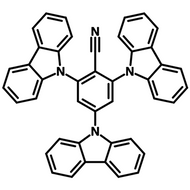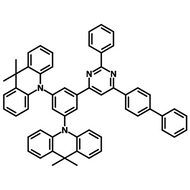Blue Dopant Materials

Blue dopant materials are highly sought after for use in full-color organic light-emitting diodes (OLEDs). Research into blue dopant OLED materials has faced issues of instability due to the high energy levels of blue photons. Blue emitters require advanced fluorescence and thermally activated delayed fluorescence (TADF) mechanisms in order to withstand the high energy demands.
The key properties of blue dopants for OLEDs include:
Popular blue dopant materials, such as 2CzPN and 4TCzBN, are donor-acceptor (D-A) based molecules designed for efficient intramolecular charge transfer (ICT). These materials feature electron-donating carbazole moieties and cyano-functionalized benzene electron-accepting groups, which generate a "push-pull" effect that facilitates efficient charge separation. This design also lowers of the singlet-triplet energy gap, enabling mechanisms like TADF. The ICT process creates an excited state that supports to high-energy blue emission, making these materials ideal for OLED applications.
Explore our range of high purity blue dopant OLED materials in order to access full-color and highly efficient OLED devices.
Jump to: Browse all Blue Dopant Materials | Resources and Support
Browse Blue Dopant Materials
Related categories: Charge transport layer materials, Dopant materials, Host materials, TADF materials, OLED materials
Filter by purification technique:
Resources and Support
Intramolecular charge transfer (ICT) refers to the transfer of charge within a single molecule (intra = “within” in Latin). In molecules containing one or more electron donor and acceptor groups, ICT can occur if the molecule is in an excited state.
Read more...Thermally Activated Delayed Fluorescence (TADF) is a mechanism by which triplet state electrons can be harvested to generate fluorescence.
Read more...








































